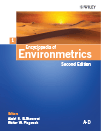Diversity Profiles†
Based in part on the article “Diversity profiles” by G. P. Patil, which appeared in the Encyclopedia of Environmetrics.
Abstract
Community diversity, diversity measurement, and diversity comparisons have been important in community ecology studies for more than four decades. Diversity is a generic term referring to the condition of being different; a useful synonym for diversity is variety. It summarizes for qualitative characteristics (e.g., tree species) what the variance summarizes for quantitative measurements (e.g., tree diameter). Diversity is looked upon as a community property and, accordingly, the trophic, taxonomic or structural levels that comprise the community must be specifically delimited in making diversity comparisons, it is not uncommon to find that diversity has increased according to one index, but decreased according to a second index. This merely reflects the fact that diversity is a complex multidimensional property of a community. To view diversity through the lens of a single index is to project that multidimensional complexity onto a one-dimensional ordinal scale. In view of the inadequacy of a single index, it is desirable to quantify diversity by means of diversity profiles. A diversity profile is a curve depicting the simultaneous values of a large collection of diversity indices. Thus, the profile portrays the views of diversity from many different vantage points simultaneously. Today in the age of indicators, however, multiple indicators of multidimensional diversity may replace the traditional diversity indices.



